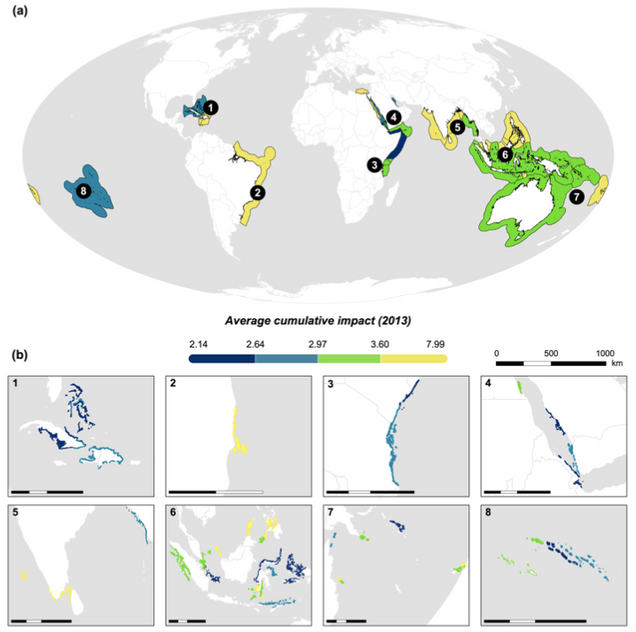Identifying Management Opportunities to Combat Climate, Land and Marine Threats Across Less Climate Exposed Coral Reefs

Conserving coral reefs is critical for maintaining marine biodiversity, protecting coastlines and supporting livelihoods in many coastal communities. Climate change threatens coral reefs globally, but researchers have identified a portfolio of bioclimatic units (BCUs), or coral reefs, that are relatively less exposed to climate impacts and connected to other reef systems. These reefs provide a proactive opportunity to secure a long-term future for coral reefs under climate change.
In a new journal article published in Conservation Biology, Blake Alexander Simmons and coauthors link threats with management actions to help prioritize and strengthen conservation and management on less climate-exposed coral reefs. To help guide local management efforts, the research team quantified cumulative human impacts (CHI) from climate, marine and land pressures within BCUs and across countries tasked with BCU management. Additionally, they created a management index based on common management measures and policies for each pressure source (climate, marine and land) to identify a country’s potential intent and/or commitment to effectively manage these pressures and to guide local management efforts within these BCUs.
Figure 1: The location and average cumulative impacts for all A) countries and B) 50 climate-resilient bioclimatic units as of 2013

Main findings:
- Overall, 22 countries (79 perecnt) experienced increases in CHI between 2008 and 2013. Climate change pressures had the highest proportional contribution to CHI across all reefs and in all but one country (Singapore), but eighteen BCUs (35 percent) and nine countries containing BCUs (32 percent) had relatively high land and marine impacts.
- There was a significant positive relationship between climate impact and the climate management index across countries, potentially signifying those countries experiencing greater climate impacts are more committed to managing them. However, this trend was driven by climate management intent in Fiji and Bangladesh.
- The results can be used to guide future fine-scale analyses, national policies and local management decisions, and the management indices reveal areas where management components can be improved. Cost-effectively managing local pressures (e.g., fishing, nutrients) within BCUs is essential for building a climate ready future that benefits both coral reefs and people.
Careful monitoring and management of coral reefs that are least exposed to climate change is essential for ensuring the greatest chances of their survival and ability to repopulate other areas in the future. By exploring the contribution of climate, land and marine pressures to cumulative human impacts, stakeholders can help prioritize conservation and management efforts to reduce the most prominent local pressures to these BCUs, thereby reducing overall human impact and increasing the resilience of these areas for future generations.
Country-level patterns can be used to guide national policies, while nuances within individual BCUs are important for guiding local management decisions. The study’s management indices also reveal areas where management components can be improved. Increased commitment to climate change policy, fine-scale analyses to further inform on-the-ground decision making and the authors argue additional consideration of potential synergies and trade-offs between pressures and overall conservation outcomes are urgently required to protect these invaluable ecosystems.
Read the Journal Article